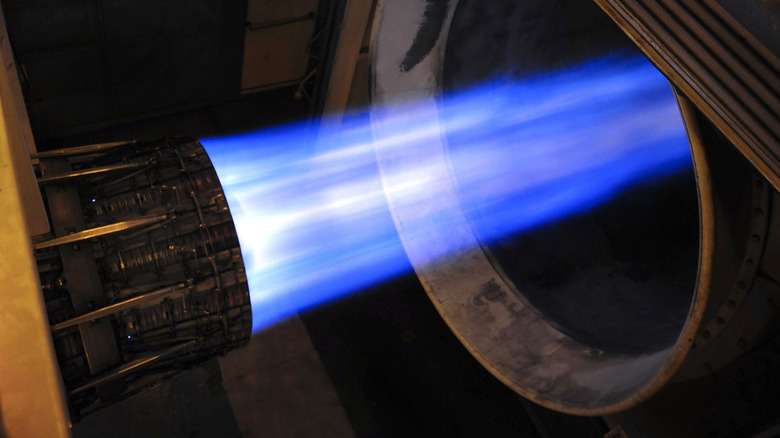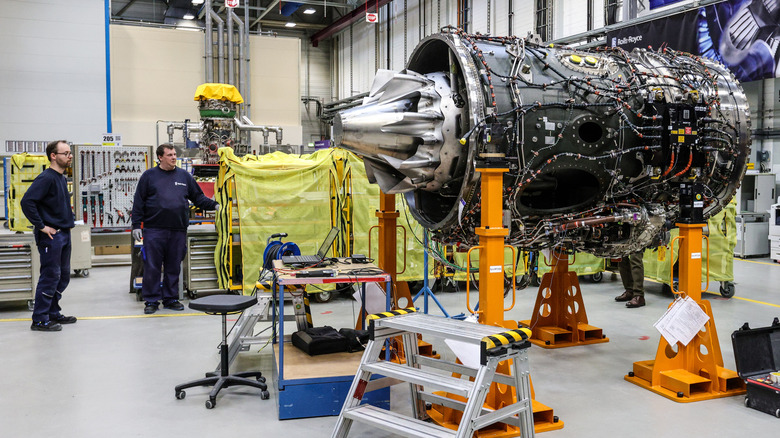How Jet Engine Output Is Measured (No, It's Not By Horsepower)
With their capability to fly higher, farther, and more efficiently, jet engines have transformed air travel since their introduction. From its origins in the 1930s, the jet engine was a substantial technological leap forward compared to the propeller-driven engines that had been in existence for 30 years. Propeller engines have several limitations, including slower speed, limited ceiling height, and restricted cargo capacity. However, due to their power, jet engines can surpass these limitations by harnessing expanding hot gases to provide propulsion. Because jet engines do not use pistons and crankshafts, their output is measured in thrust, or engine pressure ratio.
Thrust is a jet engine's output, created by converting the fuel's stored chemical energy to mechanical energy. This process powers the engine's fan blades, which move the aircraft through the air. To measure the amount of thrust from a jet engine, a specific formula, written as thrust = mass flow rate (exit velocity – inlet velocity), is used that is based on physics principles of mass and force. Testing engine thrust requires placing it in a test cell, a purpose-built facility, where it is suspended from the ceiling using specialized equipment. The engine is then connected to various instruments that monitor its different systems, including electrical, hydraulic, and fuel.
It is important to note that different variables can affect jet engine efficiency. Altitude is an important factor, as air is less dense in the upper stretches of the atmosphere, which causes a reduced amount of air to go to the engine, lowering its output. Next, airspeed also directly impacts thrust, because while it initially increases proportionate to the speed, there is a point during supersonic speeds, around Mach 3, at which the thrust begins to diminish due to the reduced heat the engine can supply its burner.
A powerful and versatile engine
Because of its capabilities, jet engines are among the engines that changed the face of warfare and have evolved to include several variants. The oldest is the turbojet, which works by compressing and heating the syphoned air, to which fuel is injected and ignited, creating intense exhaust gases that produce thrust. Next is the turbofan, which uses a large fan to drive air inside the engine, and is what the F-35 Lightning II stealth fighter uses. A turboprop, on the other hand, uses the turbine-generated force to move the propeller to create thrust. Last is the turboshaft that converts the energy created by its turbine to rotate the connected shaft, such as those found in helicopters.
The primary use of jet engines has been in aviation, where they are installed on aircraft of all categories, from small passenger craft, private jets, commercial airliners, and are the engines that power fighter jets to supersonic speeds. Another important application for jet engines is in power generation, where their exhaust is used to operate the turbines that run the generator. In addition, a version of jet engines called gas turbines is used in machinery for the oil and gas industry that moves the oil from its source through the pipeline.
Due to the immense thrust that a jet engine generates, it has enabled the creation and operation of bigger and better aircraft to transport more people and cargo over longer distances. As the fastest form of commercial transport, jet aircraft have facilitated greater trade and commerce and worldwide connectivity that was never before possible. The importance of jet engines is why further development is being conducted to create even more powerful and efficient engines in the future, including hybrid-electric and even hydrogen-fueled versions.

